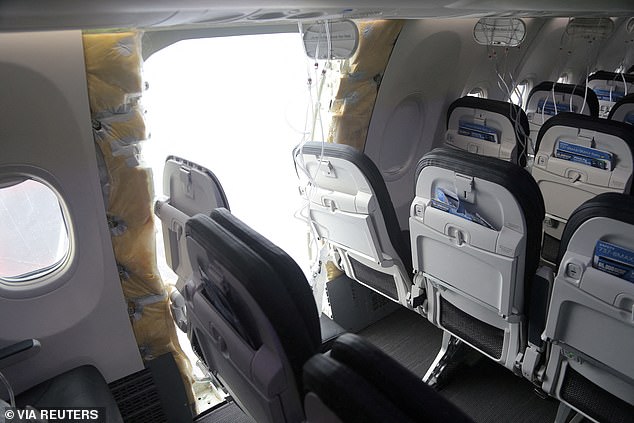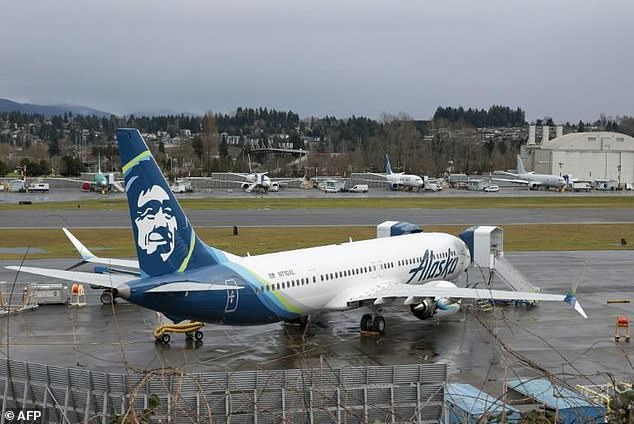Boeing boss Dave Calhoun answers questions from investors on Alaska Airlines fuselage blowout – as it emerges some are suing the company over claims they were misled on safety
- CEO Dave Calhoun said workers on the factory floor ‘know what to do’
- “How did we get here?” asked one analyst, looking for an explanation
- On January 5, a fuselage panel blew out in flight on a new 737 Max 9
Embattled Boeing executives were pressed by investors this morning for an explanation about how a door plug could have blown out of the fuselage of a 737 Max 9 plane carrying Alaska Airlines passengers this month.
Wall Street analysts wanted to know how the company allowed an improperly assembled plane off one of its production lines – and how the plane maker will respond to the ongoing crisis.
In an earnings call on the company’s fourth-quarter results, Boeing CEO David Calhoun said only that the company was responsible for the disaster and that to steady the ship it would “go slow to go fast.” .
“Whatever the specific cause of the accident, an event like this simply should not happen on an aircraft leaving one of our factories,” he said.
That became apparent on Tuesday shareholders sued the company due to accusations it favored profit over safety and misled them about its commitment to making safe aircraft.
Boeing CEO Dave Calhoun speaks after meeting with lawmakers to answer questions about the latest problems with the 737 Max

On January 5, a panel blew out of the fuselage of a 737 Max 9 plane carrying Alaska Airlines passengers
“Our men and women on the production floor and in our engineering offices know exactly what we need to do,” Calhoun said during the call.
“We are moving from slow to fast, and we will encourage and reward employees who speak out to slow things down,” he added. “We will regain trust.”
Boeing announced Wednesday that it cut its losses in the final quarter of last year, which ended days before the Alaska Airlines disaster.
Boeing posted a net loss of $30 million, compared with a loss of $663 million a year earlier. Revenue grew 10 percent year over year to $22.02 billion.
The accident involving an Alaska Airlines-operated Max 9 aircraft on January 5 has become a full-blown safety and reputation crisis for the iconic aircraft manufacturer.
In addition, regulators’ intervention may lead to slower production of jets and a loss of greater market share for narrowbody aircraft to Airbus.
Boeing said on Wednesday it was producing 737 planes at a previously agreed rate of 38 per month, a level it plans to maintain after the US Federal Aviation Administration (FAA) banned the company from halting production while it monitors was enlarged.
Increasing production of 737 Max aircraft is critical to Boeing’s recovery from a separate safety crisis stemming from two deadly crashes in 2018 and 2019 and the subsequent aerospace slump that followed due to the outbreak of the COVID -19 pandemic.
“We have taken significant steps in recent years to strengthen our safety and quality processes, but this (Alaska Air) accident makes it absolutely clear that we still have more work to do,” Calhoun said, amid mounting pressure at the top Company. brass.

Alaska Airlines has resumed service on the Boeing 737 MAX 9 after a three-week shutdown in the aftermath of an emergency landing on January 5
He also pointed to an announcement from Boeing earlier this month that it would add further quality inspections for the 737 Max and deploy a team with supplier Spirit AeroSystems, which makes and installs the plug door involved in the incident.
In its earnings release, Boeing did not provide an update to its cash flow and Max production forecast for 2025-26, amid lingering industry doubts about whether the planemaker will be able to achieve these targets following the FAA’s unprecedented decision.
During its investor day in November 2022, Boeing forecast free cash flow of approximately $10 billion over the 2025-2026 period and production of 50 per month.
Boeing, long a symbol of U.S. manufacturing prowess, has yet to report consistent positive cash flows as it has struggled to increase production over the past two years due to a fractured supply chain and nagging quality problems.
